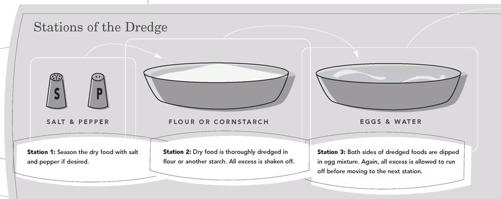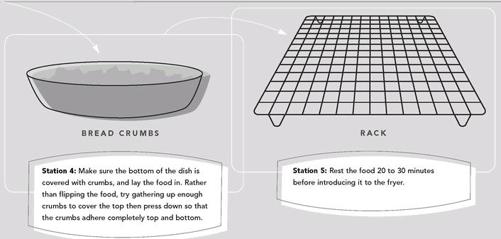I'm Just Here for the Food (19 page)
Read I'm Just Here for the Food Online
Authors: Alton Brown
Tags: #General, #Courses & Dishes, #Cooking, #Cookery

Standard breading usually consists of:
• all-purpose flour
• beaten egg (or egg white)
• “crumb” coat (could be anything from bread crumbs to crushed corn flakes)
To really shine, the crumb layer needs to make very firm contact with the food and at least a little contact with the bottom of the pan. This accomplishes two things: it holds the breading on, and it creates spots of deeper browning where crumbs actually touch the bottom of the pan.
Target foods must be in thin slabs—tofu slices, eggplant slices, tomato slices, and meats like pork chops. Odd man out: fried chicken. The flour serves as a primer coat because egg doesn’t like to stick to wet stuff. Cornstarch can also be used, but I find that flour works better with the egg. Don’t try whole wheat flour by the way, you will be disappointed.
A successful standard breading. A very thin layer of starch acts as a primer for the egg layer, which then cements on the crumb layer. Ready to cook after a 30-minute rest.
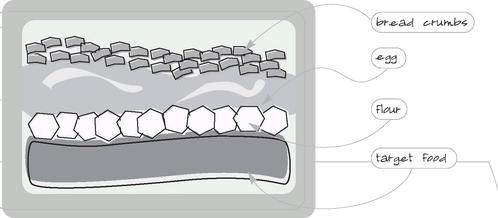
Finally, wherever there are eggs there is potential complexity. Here we’re talking a protein glue (which holds the outer crumb layer on), a browning agent (proteins), and a sealant (once set in the oil, the egg protein forms a pretty darned tight envelope). The fat in the egg attracts fat, making it possible for the cooking oil to get into the breading, which can be dangerous because if you let the fat temperature drop below 325° F the breading will go greasy.
The crumbs provide texture and insulation, further protecting the target food.
Some possible crumb layers include:
• homemade bread crumbs
• mixture of bread and cake crumbs
• panko bread crumbs (coarse Japanese bread crumbs shaped like little shards), my favorite for fried shrimp
• crushed cereal (corn flakes are especially nice, although I have a friend who uses Cap’n Crunch from time to time)
• coarsely crushed Ritz crackers: my personal favorite. I’ve been known to cut their buttery, salty goodness with gingersnaps.
• potato chips (salt and vinegar-flavored . . . yum)
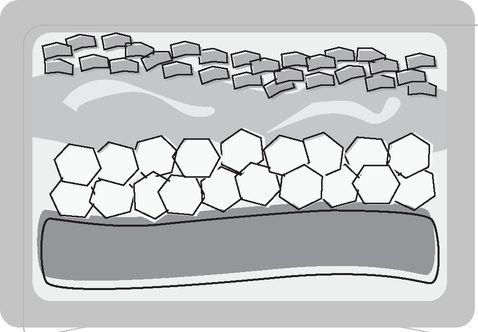
The number one reason breadings fail (fall off) is too much primer coat (flour). There is nothing to hold the layers together so they unzip from each other and your breading is floating free in the fryer, which is bad all around because all that particulate matter will only speed the degradation of the oil.

BREADING AND PAN-FRYING: THE BASIC STEPS
Manufacturing a standard breading requires that each piece of food move through a breading assembly line. If that sounds too structured for you, consider the consequences: a big mess, a hand that looks like something the Elephant Man might sport, and food that’s darned spotty lookin’.
try to wash it off in hot water and it’ll be even worse because the outside layer of flour will gelatinize.
Note: Great fryers work with a wet hand and a dry hand; that is, one hand for the flour and crumbs and one hand for the egg. Once you start layering egg, flour, and crumbs on your hand, you will be a victim of club hand and your life will be miserable.
1. Set up a breading assembly line (see Stations of the Dredge, below). Season food with salt and pepper.
2. Dredge in flour (seasoned but not salted).
3. Shake off all excess (very, very important).
4. Coat in eggs that have been beaten together with 2 teaspoons water for every egg used.
5. Coat with crumbs.
6. Let rest for 20 to 30 minutes so that the egg has time to set. You’ll be glad you did. The coated food can be wrapped, frozen, and stored for up to a month (since flavor-absorbing fat is involved, airtight wrapping is required; I generally freeze everything on a flat tray, then portion it into freezer bags).
7. Fry in fat no deeper than half the height of the food.
Immersion-Frying: Dunk ’n’ Dredge
This is my personal favorite breading method because it requires no mixing or measuring and generates a really great crust.
Target foods: seafood such as calamari and bay scallops. Also darned good on portobello mushrooms that have been cut into strips. This breading doesn’t provide much in the way of insulation, so whatever food you choose needs to be relatively small and relatively moist. Squid is perfect, baby carrots not so perfect.
1. Dip seasoned food into buttermilk (low-fat but not skim).
2. Dredge in cornstarch (sifted if you have time).
3. Fry.
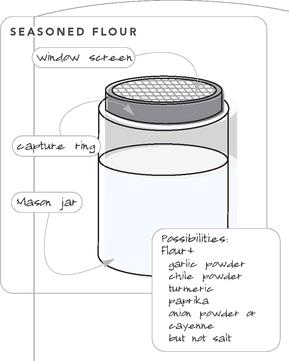
Why Hot Oil and Water Don’t Mix
Oil and water don’t mix—especially when the oil is hot and on top of your stove. When water meets with hot oil, it immediately (not to mention violently) vaporizes, aerosolizing a good bit of the already angry oil with it. Let a few molecules of this hit the heating coil and you will shortly find your kitchen in flames.
The entire effect is not unlike the cylinder in your car engine, but this time, you’re the piston.
This is not meant to scare you from deep-frying; it’s just to let you know that some things don’t forgive you if you don’t respect them. Vats of hot fat qualify. Avoiding such disasters means paying attention, that’s all. Don’t leave the room when you’re frying. And remember, fats heat much faster than equal volumes of water, so don’t try to guess the heat time—use a thermometer.
REAL SPARK PLUG AND PISTON
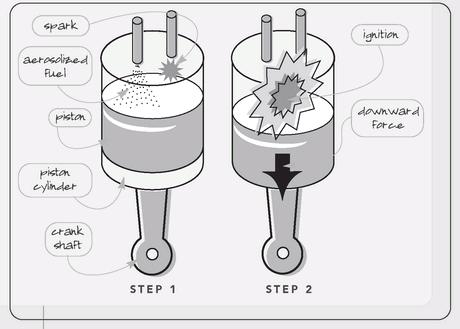
HUMAN SPARK PLUG AND PISTON
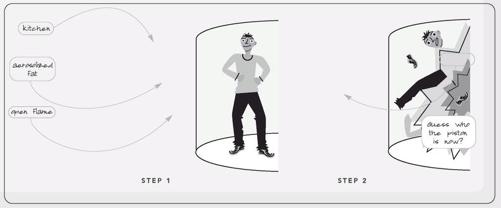
Master Profile: Frying
Heat type:
dry
Mode of transmission:
90-percent conduction, 10-percent convection
